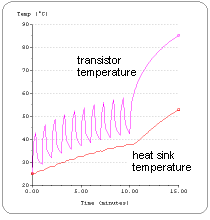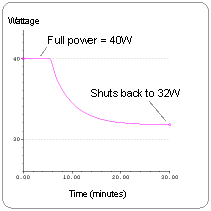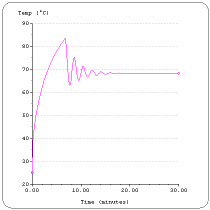Control Elements | |||||
|
In the real world, many products are subjected to duty cycle conditions, where power varies with time. The power may change according to a simple square wave, or there may be a complex waveform, as for a power surge. These are time- based problems, as the power variation is known prior to the start of the analysis. Besides time-based problems, temperature-based problems are also widespread. The most common of these is power shutback, where a component has internal circuitry to reduce power above a threshold temperature. Another temperature-based problem is thermal runaway, where power increases with temperature. Other possiblities are temperature-controlled fans and the more general thermal control problem. So temperature-based based problems are encountered frequently. It's also common to have a combination of time-based and temperature-based parameters. To deal with these complexities, Sauna provides control elements. Control elements let you quickly describe these real world variations in power and boundary temperatures. Simple cases, such as pulses, ramps and square waves, can be quickly defined with the menus. For complex waveforms, Sauna provides an easy-to-use scripting language. Sauna's features in this area are unique. Most thermal software packages only provide steady state and simple transient analysis. For the packages that do provide a duty cycle feature, the problem setup is awkward and the computation time is much longer than for Sauna. Time-based control elements: duty cycle transient
In a duty cycle problem, power (or boundary temperature) changes with time. Sauna has had sophisticated duty cycle features for over 10 years. So you can model a wide variety of problems. It is easy to model simple on/off cycles. Power surges and complex waveforms are handled with Sauna's scripting language. You can simulate performance during temperature cycling or analyze manufacturing problems, such as board pre-heat and soldering. There are many, many possibilities.
For a more detailed explanation, see the
duty cycle transient page.
Temperature-based control: power shutback, thermal control
The simplest type of temperature-based control is power shutback. Many
components incorporate a scheme which linearly reduces power above a certain
threshold temperature. One approach to thermal design stipulates that
all components should operate at full power, even under worst case conditions.
In this case the engineer just ignores shutback, which certainly simplifies
the simulation task.
But this leads to costly overdesign, as some worst case conditions are
actually rather unlikely. A better approach is to allow for some shutback,
while maintaining basic product functionality. In the example on the left,
taken from a Sauna analysis, there is some shutback. But with more than 75%
power, the product remains largely functional. Sauna allows for precise
thermal design, and wasteful overdesign is avoided.
In a more complicated situation, perhaps you are designing your own shutback loop. And you may be working with a remote reference temperature, so that stability could be a concern. These problems can also be handled with Sauna. In the example on the right, the control system shows some instability. So you could use Sauna to refine the characteristics of the control curve, temperature measurement point, etc. You can do much more with Sauna. You can also handle thermostatically controlled fans, thermal runaway (power increases with temperature), proportional control and negative heat sources. Sauna also provides wattage-based control elements, which are important when a thermoelectric cooler is incorporated into the design. And you can incorporate temperature-based control into a duty cycle analysis. Sauna's control elements let you simulate a huge variety of problems.
If you have a specific thermal control application that you wish
to discuss, feel free to contact Technical Support (734-761-1956
or
support@thermalsoftware.com.
|

 Modeling with power shutback
Modeling with power shutback
 Thermal control instability
Thermal control instability